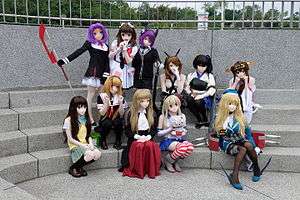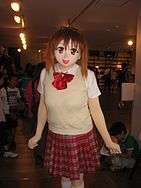Animegao kigurumi


Kigurumi, formally animegao kigurumi and occasionally known as a doller, is a type of cosplay using a masked character costume to portray anime or cartoon characters in the real world. The face of the performer is fully covered with a stylized mask, and the costume of the character is worn. Used in stage shows, the concept of animegao kigurumi was then adopted by cosplayers, who made custom masks of various characters. In Japan, most cosplayers refer to this style as (アニメ顔 - animegao, or "anime face"), while performers are sometimes called "dollers". It is still a very minor part of the cosplay scene in Japan, though around 2005, it began attracting attention in other countries, including the United States, Canada, and European countries.
As with other kinds of cosplay, many hobbyists have costumes of established characters from games or animations. The characters are usually female, and commonly human, although kigurumi characters of other races and genders do exist, including male (such as Kenshin Himura from Rurouni Kenshin/Samurai X), mechanical (such as Gundam Wing), elfin (such as Deedlit or Pirotess from Lodoss), and demonic (such as Inuyasha from the anime of the same name). Some kigurumi are original characters created by the performer.
By wearing a body suit and mask, kigurumi cosplayers are able to get closer to the appearance of the original character, especially in the case of animal characters or highly stylised characters. Nonprofessional animal kigurumi cosplayers (also known as "fursuiters" mostly by furries), painstakingly make detailed heads and bodies from foam, plastic, wire, artificial fur, and other materials. In animegao kigurumi, the performer playing a humanoid anime character wears a flesh-coloured body suit (known as a zentai) and matching mask usually moulded from clay or fiberglass composites. The body suit allows them less-detailed skin features, on the level of animated characters, and the mask allows a similar level of facial features. Some hobbyists obtain masks from established hobbyist mask studios such as Build Up Studio SIGMA[1] or Dolphin Factory.[2]
Though this term originated as a translation of アニメ顔, the original Japanese term is not used to describe masking based on anime characters. Instead, the term 着ぐるみ (きぐるみ, kigurumi) is used by most performers.
-

This exemplary doller leaves no part of their skin exposed.
See also
References
External links
| Wikimedia Commons has media related to Animegao. |
- Kigurumi Online
- Kigurumi Cosplay Society
- Kiki Feegata, "A brief History of Western Kigurumi", Kigurumi Online, 10 August 2015.
- Mask Creators
- Japan: Ayame Stores (あやめ商店), Build Up Studio SIGMA, Karasuzu, Kyoto Alice Workshop, Iluca
- Canada: Justin Bailey's Kigurumi and Props
- Hong Kong: Kaga Ki
- Malaysia: Kwonder
- Russia: Doll's Kingdom AG
- Taiwan: Goukaou GKO
- United Kingdom: Charming Kitsune Kigurumi Studio
- United States: Ride the Pig Studio